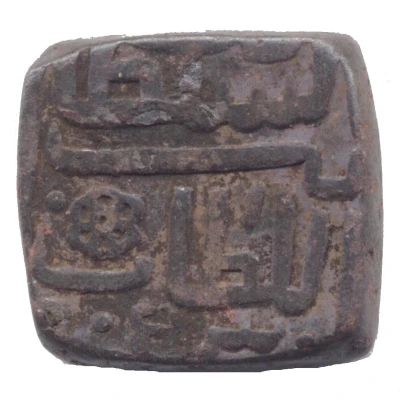


© Maneeshks (CC BY-NC)
½ Falus - Ghiyath Shah Khalji
| Copper | 4.04 g | - |
| Issuer | Sultanate of Malwa (Indian Sultanates) |
|---|---|
| Type | Standard circulation coin |
| Years | 872-903 (1468-1498) |
| Calendar | Islamic (Hijri) |
| Value | ½ Falus |
| Currency | Tanka (1401-1562) |
| Composition | Copper |
| Weight | 4.04 g |
| Size | 13.75 × 13 mm |
| Thickness | 3 mm |
| Shape | Square (irregular, 40 rati coin) |
| Technique | Hammered (Weight varies 4-4.6g) |
| Orientation | Variable alignment ↺ |
| Demonetized | Yes |
| Updated | 2024-10-05 |
| Numista | N#68397 |
|---|---|
| Rarity index | 85% |
Reverse
Al-sultan bin al-sultan
Script: Arabic
Edge
Plain
Comment
CoinageThe copper coinage of Ghiyath Shah (on the sultans who succeeded him) is characterised by its square format. They were introduced in AH 877. These square coins were struck on the 80 rati standard of around 9g. A few round copper coins were also struck. In AH 906 the weight of the Falus was changed to 100 rati standard of around 12g.
This particular coin is struck on the 80 rati standard. There are many variations of the obverse and reverse of this coin. Goron & Goenka lists four variations of this variety. One of those variations is the coin shown above. Another variation is shown below:
History
The Malwa Sultanate was a late medieval independent kingdom in the Malwa region of the present day Madhya Pradesh state in India in 1392-1562. The sultanate of Malwa was founded by Dilawar Khan Ghuri, the governor of the Delhi Sultanate in Malwa, who asserted his independence in 1392 but did not actually assume the ensigns of royalty till 1401. Initially Dhar was the capital of the new kingdom, but soon it was shifted to Mandu which was renamed Shadiabad (the city of joy). After his death, he was succeeded by his son Alp Khan, who assumed the title of Hoshang Shah.
The Ghuri dynasty founded by Dilawar Khan Ghuri was replaced by Mahmud Shah I, who proclaimed himself king on May 16, 1436. The Khilji dynasty founded by him ruled over Malwa till 1531. Mahmud I was succeeded by his eldest son Ghiyas-ud-Din. The last days of Ghiyas-ud-Din was embittered by a struggle for throne between his two sons, Nasir-ud-Din and Ala-ud-Din. Nasir-ud-Din emerged victorious and ascended the throne on October 22, 1500. The last ruler Mahmud Shah II surrendered to Bahadur Shah, the sultan of Gujarat after the fort of Mandu fell to Bahadur on May 25, 1531. During 1531 - 1537 the kingdom was under the control of Bahadur Shah though the Mughal emperor Humayun captured it for a short period during 1535-36.
In 1537 Qadir Shah, an ex-officer of the previous Khilji dynasty rulers regained control over a part of the erstwhile kingdom. But in 1542, Sher Shah Suri conquered the kingdom defeating him and appointed Shuja'at Khan as the governor. His son, Baz Bahadur declared himself independent in 1555. In 1561 Akbar's army led by Adham Khan and Pir Muhammad Khan attacked Malwa and defeated Baz Bahadur in the battle of Sarangpur on 29 March, 1561. Akbar soon recalled Adham Khan and made over command to Pir Muhammad. Pir Muhammad attacked Khandesh and proceeded up to Burhanpur but he was defeated by a coalition of three powers: Miran Mubarak Shah II of Khandesh, Tufal Khan of Berar and Baz Bahadur. Pir Muhammad died while retreating. The confederate army pursued the Mughals and drove them out of Malwa. Baz Bahadur regained his kingdom for a short period. In 1562 Akbar sent another army led by Abdullah Khan, the Uzbeg, which finally defeated Baz Bahadur. He fled to Chittor.It became a Subah of the Mughal Empire and Abdullah Khan became its first governor.
Interesting fact
One interesting fact about this coin is that it was issued during the reign of Ghiyath Shah Khalji, who was known for his military campaigns and administrative reforms, and it features an unique blend of Islamic and Hindu architectural styles on its design.



